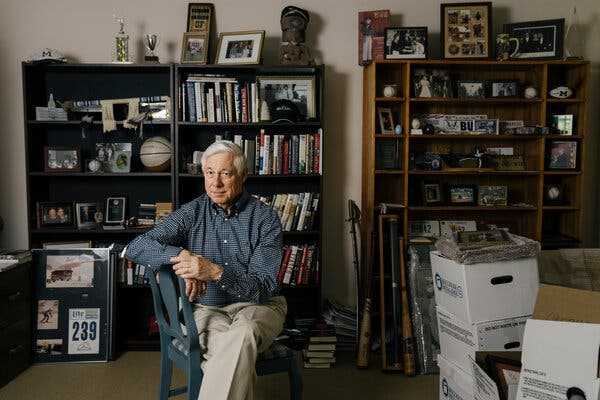Officials said Russia was planning a fake video showing an attack by Ukrainians on Russian territory or Russian speakers in eastern Ukraine.

A Ukrainian soldier near Trokhizbenka in eastern Ukraine. Officials said Russia intended to use the video to accuse Ukraine of genocide against Russian-speaking people.
WASHINGTON — The United States has acquired intelligence about a Russian plan to fabricate a pretext for an invasion of Ukraine using a faked video that would build on recent disinformation campaigns, according to senior administration officials and others briefed on the material.
The plan — which the United States hopes to spoil by making public — involves staging and filming a fabricated attack by the Ukrainian military either on Russian territory or against Russian-speaking people in eastern Ukraine.
Russia, the officials said, intended to use the video to accuse Ukraine of genocide against Russian-speaking people. It would then use the outrage over the video to justify an attack or have separatist leaders in the Donbas region of eastern Ukraine invite a Russian intervention.
Officials would not release any direct evidence of the Russian plan or how they learned of it, saying to do so would compromise their sources and methods. But both a recent Russian disinformation campaign focused on false accusations of genocide and the recent political actions being taken in the Russian parliament to recognize breakaway governments in Ukraine lent credence to the intelligence.
If carried out, the Russian operation would be an expansion of a propaganda theme that American intelligence officials and outside experts have said Moscow has been pushing on social media, on conspiracy sites and with state-controlled media since November.
The video was intended to be elaborate, officials said, with plans for graphic images of the staged, corpse-strewn aftermath of an explosion and footage of destroyed locations. They said the video was also set to include faked Ukrainian military equipment, Turkish-made drones and actors playing Russian-speaking mourners.
American officials would not say who in Russia precisely was planning the operation, but a senior administration official said Russian intelligence was “intimately involved” in the effort.
Understand Russia’s Relationship With the West
The tension between the regions is growing and Russian President Vladimir Putin is increasingly willing to take geopolitical risks and assert his demands.
- Competing for Influence: For months, the threat of confrontation has been growing in a stretch of Europe from the Baltic Sea to the Black Sea.
- Threat of Invasion: As the Russian military builds its presence near Ukraine, Western nations are seeking to avert a worsening of the situation.
- Energy Politics: Europe is a huge customer of Russia’s fossil fuels. The rising tensions in Ukraine are driving fears of a midwinter cutoff.
- Migrant Crisis: As people gathered on the eastern border of the European Union, Russia’s uneasy alliance with Belarus triggered additional friction.
- Militarizing Society: With a “youth army” and initiatives promoting patriotism, the Russian government is pushing the idea that a fight might be coming.
A British government official said they had done their own analysis of the intelligence and had high confidence that Russia was planning to engineer a pretext to blame Ukraine for an attack. The details of the intelligence, the official said, are “credible and extremely concerning.”
While it is not clear that senior Russian officials approved the operation, it was far along in the planning and the United States had high confidence that it was under serious consideration, officials said. Russian officials had found corpses to use in the video, discussed actors to play mourners and plotted how to make military equipment in the video appear Ukrainian or NATO-supplied.
While the plan sounded far-fetched, American officials said they believed it could have worked to provide a spark for a Russian military operation — an outcome they said they hoped would be made less likely by exposing the effort publicly.
The highlights of the intelligence have been declassified, in hopes of both derailing the plot and convincing allies of the seriousness of the Russian planning. The officials interviewed for this article requested anonymity to discuss declassified but sensitive intelligence before it was released publicly.
Live Updates: Russia-Ukraine Tensions
Updated Feb. 3, 2022, 12:25 p.m. ET
- Russia says it will shut down a German state broadcaster.
- Russia and Belarus prepare for military drills, while Ukraine rejects spying allegations.
- Turkish president agrees to provide Ukraine drones, but also offers to serve as a mediator with Russia.
Avril D. Haines, the director of national intelligence, and other top administration officials briefed members of Congress on the material on Thursday. Details of the information have also been shared with allies, as the United States and Britain push a kind of intelligence diplomacy.
In recent weeks, both Washington and London have outlined elements of Moscow’s war planning, highlighting planned troop buildups, exposing a false-flag sabotage plot and revealing Russian plans to install a friendly government in Kyiv.
The strategy aims to persuade allies that Russia is not posturing and has real war plans that it could put into effect. The releases also aim to force Russia to drop and redraft plans, further delaying any invasion plan.
The longer the international community can delay a decision by President Vladimir V. Putin about whether to approve a military operation against Ukraine, the more of a chance there is that he will reconsider his plans, according to diplomats.
Some officials in the United States and Britain think Mr. Putin has underestimated how many casualties his military would suffer in any direct invasion of Ukraine.
The intelligence diplomacy push is modeled in part on Britain’s efforts to rally a strong response to the Russian nerve agent attack in England in 2018. The British government publicly released information on Russian involvement and shared other intelligence privately as it pushed allies to expel Russian diplomats in response.
Understand the Escalating Tensions Over Ukraine
Card 1 of 5
A brewing conflict. Antagonism between Ukraine and Russia has been simmering since 2014, when the Russian military crossed into Ukrainian territory, annexing Crimea and whipping up a rebellion in the east. A tenuous cease-fire was reached in 2015, but peace has been elusive.
A spike in hostilities. Russia has recently been building up forces near its border with Ukraine, and the Kremlin’s messaging toward its neighbor has hardened. Concern grew in late October, when Ukraine used an armed drone to attack a howitzer operated by Russian-backed separatists.
Ominous warnings. Russia called the strike a destabilizing act that violated the cease-fire agreement, raising fears of a new intervention in Ukraine that could draw the United States and Europe into a new phase of the conflict.
The Kremlin’s position. President Vladimir V. Putin of Russia, who has increasingly portrayed NATO’s eastward expansion as an existential threat to his country, said that Moscow’s military buildup was a response to Ukraine’s deepening partnership with the alliance.
Rising tension. Western countries have tried to maintain a dialogue with Moscow. But administration officials recently warned that the U.S. could throw its weight behind a Ukrainian insurgency should Russia invade.
The move to publicize the plan comes as the Duma, Russia’s lower house of parliament, begins to consider legislation to recognize eastern Ukraine as an independent territory, much as Moscow has recognized Russian-occupied areas of Georgia.
If the Russian parliament were to recognize the Donbas region of Ukraine as an independent state, a Moscow-appointed leader of that breakaway state could then request help from Mr. Putin. Mr. Putin has argued many times that in such a case, an intervention would be in keeping with international law and precedents set by the United States.
American officials believe the plans for the video included Turkish-made Bayraktar TB2 drones that have been used by the Ukrainian Army.
Last year, after an artillery attack killed a Ukrainian soldier, the Ukrainian Army used one of the drones to launch a counterattack on a howitzer used by Russian-led separatist forces. Russia scrambled jets, and the situation escalated.
Russian disinformation in recent weeks has falsely accused NATO of planning an invasion or intervention in Ukraine. Highlighting the presence of weapons made by Turkey, a NATO ally, would allow the Russians to accuse the alliance of raising tensions in the conflict and being culpable in the death of Russian speakers.
The draft law under consideration in Russia would recognize what Moscow calls the Donetsk and Luhansk People’s Republics. Russia considered recognizing governments in the separatist-controlled region in 2014 but ultimately backed down.
The proposal was revived by members of the Communist Party, the second-largest faction in the Russian Duma, in recent days. The Russian parliamentarians pushing the law have argued that Ukraine is planning an offensive to reassert control of the area. If that happens, the Russian lawmakers argue, Russian-speaking residents will be denied basic rights.
Ukrainian oppression of Russian speakers in eastern Ukraine is a common theme of Russian state media and websites controlled by Russian intelligence services. But the reality is that language is not the hard dividing line in Ukraine that Moscow suggests.
Source: nytimes.com



